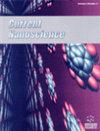生长时间对化学合成 TiO2 纳米结构和光学特性的影响
IF 1.5
4区 材料科学
Q4 BIOTECHNOLOGY & APPLIED MICROBIOLOGY
引用次数: 0
摘要
导言:二氧化钛(TiO2)因其在光电设备、太阳能电池、气体传感器、光催化试剂和生物医学领域的广泛应用而备受科学界青睐。它是一种宽带隙半导体,带隙为 3.2eV。根据合成方法和退火温度的不同,它通常会呈现出锐钛矿、金红石和褐铁矿等三种不同的相。方法:在此,我们报告了一种在低温下合成二氧化钛纳米结构(NSs)的简单化学工艺,以研究生长时间对结构和形态特性的影响。在合成过程中,我们允许样品生长 5 小时(样品-T5)和 7 小时(样品-T7),并继续相应的搅拌过程。我们对样品进行了 XRD、UV-Vis 和 FESEM 分析。结果XRD 证实了生长时间对结构尺寸的影响,紫外可见光谱中观察到吸收边的移动,这表明带隙发生了变化。FESEM 证实了两种样品中纳米结构尺寸的变化。结论生长时间变化导致的带隙调整可能是现代科学应用中一个值得探索的有趣现象。本文章由计算机程序翻译,如有差异,请以英文原文为准。
Effect of Growth Time on Structural and Optical Properties of Chemically Synthesized TiO2 Nanostructures
Introduction: Titanium Dioxide (TiO2) is popular in the scientific community due to its wide variety of applications in optoelectronic devices, solar cells, gas sensors, photocatalytic reagents, and the biomedical industry. It is a wide band gap semiconductor with a band gap of 3.2eV. Usually, it shows three different phases, like anatase, rutile, and brookite, based on the synthesis method and annealing temperature. Method: Here, we report a simple chemical process to synthesize TiO2 nanostructures (NSs) at low temperatures to study the impact of growth time on structural and morphological properties. During synthesis, we permitted the samples to grow for 5 hr (sample-T5) and 7 hr (sample-T7) and continued the stirring process accordingly. We performed XRD, UV-Vis, and FESEM analysis with the samples. Result: XRD confirmed the effect of growth time on the size of the structures, and a shift in the absorption edge was observed in UV-Vis spectra, which indicated a change in the band gap. FESEM confirmed the change in nanostructures’ size in both samples. Conclusion: The tuning in band gap due to growth time variation may be an interesting phenomenon to explore for modern scientific applications.
求助全文
通过发布文献求助,成功后即可免费获取论文全文。
去求助
来源期刊

Current Nanoscience
工程技术-材料科学:综合
CiteScore
3.50
自引率
6.70%
发文量
83
审稿时长
4.4 months
期刊介绍:
Current Nanoscience publishes (a) Authoritative/Mini Reviews, and (b) Original Research and Highlights written by experts covering the most recent advances in nanoscience and nanotechnology. All aspects of the field are represented including nano-structures, nano-bubbles, nano-droplets and nanofluids. Applications of nanoscience in physics, material science, chemistry, synthesis, environmental science, electronics, biomedical nanotechnology, biomedical engineering, biotechnology, medicine and pharmaceuticals are also covered. The journal is essential to all researches involved in nanoscience and its applied and fundamental areas of science, chemistry, physics, material science, engineering and medicine.
Current Nanoscience also welcomes submissions on the following topics of Nanoscience and Nanotechnology:
Nanoelectronics and photonics
Advanced Nanomaterials
Nanofabrication and measurement
Nanobiotechnology and nanomedicine
Nanotechnology for energy
Sensors and actuator
Computational nanoscience and technology.
 求助内容:
求助内容: 应助结果提醒方式:
应助结果提醒方式:


